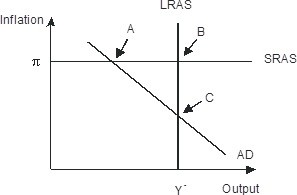Which of the following correctly describes a way in which deficit spending can impose a burden on future generations? I
Failure to allocate deficit spending to uses that boost future real Gross Domestic Product (GDP) will require taxing future generations at a higher rate to repay the resulting higher public debt. II. Government deficits that lead to higher employment and real Gross Domestic Product (GDP) in the future will generate increased income taxes for future governments, which will respond by spending the higher tax revenues, creating higher future government budget deficits. III. Other things being equal, deficit spending fuels increased consumption of goods and services by the current generation that crowds out capital investment, thereby leaving future generations with a smaller stock of capital than otherwise would have existed. A) I only
B) II only
C) I and III only
D) II and III only
C
You might also like to view...
The economy pictured in the figure below has a(n) ________ gap with a short-run equilibrium combination of inflation and output indicated by point ________. 
A. recessionary; B B. recessionary; C C. recessionary; A D. expansionary; A
If increasing the admission charge for National Parks increases the National Park Service's total revenue, then the demand for National Park visits is:
A. inelastic. B. elastic. C. perfectly elastic. D. a perfectly horizontal line.
Which of the following probably best explains why trade restrictions are imposed even if the costs to consumers are greater than the benefits to protected industries?
a. Indifference on the government's part to the interests of domestic workers b. A desire to make other countries suffer c. Government's desire to earn high revenues d. Successful lobbying by employers and workers in protected industries e. Government's preference to safeguard the interest of the producers at the expense of the consumers
A person buys a newly issued bond that matures in 10 years with a face value of $10,000 and a coupon rate of 4%. How much money will the bondholder receive in the tenth year?
A) $10,040. B) $10,400. C) $10,000. D) $40. E) ?$400.